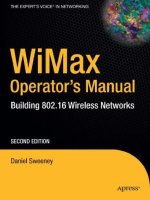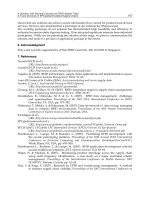Designing and deploying 802 11n wireless networks
Bạn đang xem bản rút gọn của tài liệu. Xem và tải ngay bản đầy đủ của tài liệu tại đây (5.65 MB, 529 trang )
Designing and Deploying
802.11n Wireless
Networks
Jim Geier
Cisco Press
800 East 96th Street
Indianapolis, IN 46240
ii
Designing and Deploying 802.11n Wireless Networks
Designing and Deploying 802.11n Wireless Networks
Jim Geier
Copyright © 2010 Cisco Systems, Inc.
Published by:
Cisco Press
800 East 96th Street
Indianapolis, IN 46240 USA
All rights reserved. No part of this book may be reproduced or transmitted in any form or by any means,
electronic or mechanical, including photocopying, recording, or by any information storage and retrieval
system, without written permission from the publisher, except for the inclusion of brief quotations in a
review.
Printed in the United States of America
First Printing June 2010
Library of Congress Cataloging-in-Publication Data
Geier, James T.
Designing and deploying 802.11n wireless networks / Jim Geier.
p. cm.
ISBN 978-1-58705-889-9 (hardcover)
1. Wireless LANs. 2. IEEE 802.11 (Standard) I. Title.
TK5105.78.G448 2010
004.6'8--dc22
2010019130
ISBN-13: 978-1-58705-889-9
ISBN-10: 1-58705-889-8
Warning and Disclaimer
This book is designed to provide information about wireless networking, which includes Cisco products.
Every effort has been made to make this book as complete and as accurate as possible, but no warranty or
fitness is implied.
The information is provided on an “as is” basis. The authors, Cisco Press, and Cisco Systems, Inc. shall have
neither liability nor responsibility to any person or entity with respect to any loss or damages arising from the
information contained in this book or from the use of the discs or programs that may accompany it.
The opinions expressed in this book belong to the author and are not necessarily those of Cisco Systems, Inc.
Trademark Acknowledgments
All terms mentioned in this book that are known to be trademarks or service marks have been appropriately capitalized. Cisco Press or Cisco Systems, Inc. cannot attest to the accuracy of this information. Use
of a term in this book should not be regarded as affecting the validity of any trademark or service mark.
iii
Corporate and Government Sales
The publisher offers excellent discounts on this book when ordered in quantity for bulk purchases or special sales, which may include electronic versions and/or custom covers and content particular to your business, training goals, marketing focus, and branding interests. For more information, please contact: U.S.
Corporate and Government Sales 1-800-382-3419
For sales outside the United States please contact: International Sales
Feedback Information
At Cisco Press, our goal is to create in-depth technical books of the highest quality and value. Each
book is crafted with care and precision, undergoing rigorous development that involves the unique
expertise of members from the professional technical community.
Readers’ feedback is a natural continuation of this process. If you have any comments regarding how
we could improve the quality of this book, or otherwise alter it to better suit your needs, you can
contact us through e-mail at Please make sure to include the book title
and ISBN in your message.
We greatly appreciate your assistance.
Publisher: Paul Boger
Cisco Representative: Erik Ullanderson
Associate Publisher: Dave Dusthimer
Cisco Press Program Manager: Anand Sundaram
Executive Editor: Mary Beth Ray
Technical Editors: Tom Carpenter and Christian Estes
Managing Editor: Sandra Schroeder
Copy Editor: Keith Cline
Senior Development Editor: Christopher Cleveland
Indexer: Bill Meyers
Project Editor: Mandie Frank
Proofreader: Kathy Ruiz
Editorial Assistant: Vanessa Evans
Cover and Interior Designer: Louisa Adair
Composition: Mark Shirar
Americas Headquarters
Cisco Systems, Inc.
San Jose, CA
Asia Pacific Headquarters
Cisco Systems (USA) Pte. Ltd.
Singapore
Europe Headquarters
Cisco Systems International BV
Amsterdam, The Netherlands
Cisco has more than 200 offices worldwide. Addresses, phone numbers, and fax numbers are listed on the Cisco Website at www.cisco.com/go/offices.
CCDE, CCENT, Cisco Eos, Cisco HealthPresence, the Cisco logo, Cisco Lumin, Cisco Nexus, Cisco StadiumVision, Cisco TelePresence, Cisco WebEx, DCE, and Welcome to the Human Network are trademarks; Changing the
Way We Work, Live, Play, and Learn and Cisco Store are service marks; and Access Registrar, Aironet, AsyncOS, Bringing the Meeting To You, Catalyst, CCDA, CCDP, CCIE, CCIP, CCNA, CCNP, CCSP, CCVP, Cisco, the
Cisco Certified Internetwork Expert logo, Cisco IOS, Cisco Press, Cisco Systems, Cisco Systems Capital, the Cisco Systems logo, Cisco Unity, Collaboration Without Limitation, EtherFast, EtherSwitch, Event Center, Fast Step,
Follow Me Browsing, FormShare, GigaDrive, HomeLink, Internet Quotient, IOS, iPhone, iQuick Study, IronPort, the IronPort logo, LightStream, Linksys, MediaTone, MeetingPlace, MeetingPlace Chime Sound, MGX, Networkers,
Networking Academy, Network Registrar, PCNow, PIX, PowerPanels, ProConnect, ScriptShare, SenderBase, SMARTnet, Spectrum Expert, StackWise, The Fastest Way to Increase Your Internet Quotient, TransPath, WebEx, and
the WebEx logo are registered trademarks of Cisco Systems, Inc. and/or its affiliates in the United States and certain other countries.
All other trademarks mentioned in this document or website are the property of their respective owners. The use of the word partner does not imply a partnership relationship between Cisco and any other company. (0812R)
iv
Designing and Deploying 802.11n Wireless Networks
About the Author
Jim Geier is the founder and principal consultant of Wireless-Nets, Ltd., an independent
consulting firm assisting organizations with the development and deployment of wireless
networks. His 25 years of experience includes the planning, analysis, design, implementation, installation, and support of numerous wireless network-based solutions for enterprises, municipalities, hospitals, universities, airports, warehouses, and product manufacturers worldwide. Jim is the author of more than a dozen books, including Deploying
Voice over Wireless LANs (Cisco Press), Wireless Networks: First Step (Cisco Press),
Implementing 802.1X Security Solutions (Wiley), and Network Reengineering
(McGraw-Hill). He is the author of numerous tutorials and other publications and has
developed and instructed dozens of training courses on wireless networking topics. Jim
has been active within the Wi-Fi Alliance, responsible for certifying interoperability of
802.11 (Wi-Fi) wireless LANs. He has also been active with the IEEE 802.11 Working
Group, responsible for developing international standards for wireless LANs. He served
as Chairman of the IEEE Computer Society, Dayton Section, and Chairman of the IEEE
International Conference on Wireless LAN Implementation. Jim’s education includes a
Bachelor’s and Master’s degree in electrical engineering, with emphasis in wireless communications.
Jim Geier’s contact information:
E-mail:
Website: www.wireless-nets.com
About the Technical Reviewers
Tom Carpenter is the Senior Consultant for the Systems Education and Consulting
Company (SYSEDCO) located in Marysville, Ohio. Tom holds several industry certifications, including CWNA, CWSP, and vendor-specific certifications in the wireless industry. He has authored several books on wireless networking and VoIP and database solutions, and he speaks regularly at training events and technical conferences. Tom lives with
his wife and four wonderful children in central Ohio.
Christian J. Estes is a Senior Wireless Engineer on the Escalation / CAP Team in the
Wireless Business Unit at Cisco Systems, located in Silicon Valley. During the four years
he has been at Cisco, he has participated in the design, deployment, and remediation of
enterprise class wireless architectures and specializes in Voice over Wireless LAN technologies, protocols, and applications. He was a member of the CCIE Certification
Development Team for the Wireless track and holds the CCNP, CCVP, and CWNE certifications. In addition, he is currently in the process of acquiring the CCIE certification.
He has degrees in computer engineering and organizational leadership and is currently
pursuing a graduate degree from Stanford University in management science and engineering.
v
Dedications
I dedicate this book to my wife, Debbie.
Acknowledgments
I want to thank the Pearson production team for their time and effort with creating this
book:
■
Thanks to Mary Beth Ray for getting this book contracted and managing the process
from beginning to end.
■
Thanks to Christopher Cleveland, Mandie Frank, and Keith Cline for their fantastic
editing of the book.
■
Thanks to the many others at Pearson who were part of developing and producing
this book.
I also want to thank Tom Carpenter for providing technical feedback on the many topics
that this book covers. Also, thanks to Christian Estes for providing technical feedback
about Cisco solutions.
vi
Designing and Deploying 802.11n Wireless Networks
Contents at a Glance
Introduction
xxv
Part I
Fundamental Concepts
Chapter 1
Introduction to Wireless LANs
Chapter 2
Radio Wave Fundamentals
Chapter 3
Wireless LAN Types and Components
Chapter 4
Wireless LAN Implications
Part II
The 802.11 Standard
Chapter 5
Introduction to IEEE 802.11 and Related Standards
Chapter 6
IEEE 802.11 Medium Access Control (MAC) Layer
Chapter 7
IEEE 802.11 Physical Layers
Part III
Wireless Network Design
Chapter 8
Planning a Wireless LAN Deployment
Chapter 9
Defining Requirements for a Wireless LAN
Chapter 10
System Architecture Considerations
Chapter 11
Range, Performance, and Roaming Considerations
Chapter 12
Radio Frequency Considerations
Chapter 13
Security Considerations
Part IV
Wireless Network Installation and Testing
Chapter 14
Test Tools
Chapter 15
Performing a Wireless Site Survey
Chapter 16
Installing and Configuring a Wireless LAN
Chapter 17
Testing a Wireless LAN
Part V
Operational Support Considerations
Chapter 18
Managing a Wireless LAN
Chapter 19
Troubleshooting a Wireless LAN
Chapter 20
Preparing Operational Support Staff
Glossary
Index
1
39
55
87
463
135
177
201
237
263
299
327
339
353
455
115
367
387
405
421
439
449
vii
Contents
Introduction
xxv
Part I
Fundamental Concepts
Chapter 1
Introduction to Wireless LANs
1
Wireless LAN Markets and Applications
Retail
1
2
Warehousing
3
Healthcare
4
Hospitality
9
Voice over WLAN
9
Video Surveillance
11
Home and Small Office
12
General Enterprise Systems
13
Location-Aware Wireless Applications
Benefits of Wireless Networks
Mobility
13
15
15
Installation in Difficult-to-Wire Areas
Increased Reliability
17
Reduced Installation Time
Long-Term Cost Savings
17
17
Productivity Gain Is the Answer
Wireless Network Technologies
IEEE 802.11 (Wi-Fi)
Initial 802.11
802.11a
21
802.11b
21
802.11g
22
802.11n
23
16
18
19
20
20
Comparison of 802.11 Standards
Wi-Fi Certification
24
24
Other Wireless Network Technologies
IEEE 802.16 (WiMAX)
IEEE 802.15 (Bluetooth)
IEEE 802.15.4 (ZigBee)
26
30
32
26
viii
Designing and Deploying 802.11n Wireless Networks
Certified Wireless USB
33
Wireless LANs: A Historical Perspective
The Early Days
Initial 802.11 Standardization
802.11n Standardization
Chapter 2
Radio Wave Attributes
40
Frequency
40
Phase
35
36
Radio Wave Fundamentals
Amplitude
34
34
39
39
41
RF System Components
RF Transceiver
41
41
RF Modulation
43
Amplitude Shift-Keying
43
Frequency Shift-Keying
44
Phase Shift-Keying
45
Quadrature Amplitude Modulation
Spread Spectrum
45
45
Orthogonal Frequency-Division Multiplexing
RF Signal Propagation
Attenuation
48
48
Free Space Loss
49
Physical Obstacles
50
Multipath Propagation
51
Noise and Signal-to-Noise Ratio
RF Mathematics
53
Converting Units
Chapter 3
51
53
Wireless LAN Types and Components
Types of Wireless LANs
55
Ad Hoc Wireless LANs
55
Infrastructure Wireless LANs
Mesh Wireless Networks
Wireless LAN Components
Client Devices
Client Radio
57
59
62
62
63
Industry Standard Architecture
65
55
48
ix
Peripheral Component Interconnect
Mini-PCI
PC Card
66
66
ExpressCard
67
CompactFlash
67
Universal Serial Bus
Access Points
67
68
Autonomous Access Points
68
Controller-Based Access Points
Wi-Fi Routers
Mesh Nodes
Antennas
Bridges
69
69
72
72
RF Amplifiers
Repeaters
74
75
75
Network Infrastructure Components
Network Distribution Systems
Switches
77
77
77
Optical Fiber
79
Power over Ethernet
79
Application Connectivity Software
Terminal Emulation
83
Direct Database Interfaces
Wireless Middleware
Security Vulnerabilities
87
87
88
Unauthorized Access
Denial of Service
84
84
Wireless LAN Implications
Passive Monitoring
82
82
Browser-Based Approaches
Chapter 4
66
91
95
Radio Signal Interference
97
Microwave Oven Interference
Cordless Phone Interference
Bluetooth Interference
99
101
103
Neighboring Wireless LAN Interference
Impacts of Multipath Propagation
108
105
x
Designing and Deploying 802.11n Wireless Networks
Roaming Issues
109
Battery Limitations
110
Interoperability Problems
Installation Issues
111
112
Part II
The 802.11 Standard
Chapter 5
Introduction to IEEE 802.11 and
Related Standards 115
The Importance of Standards
Types of Standards
115
115
Institute for Electrical and Electronic Engineers
Benefits of the 802.11 Standard
117
Appliance Interoperability
118
Fast Product Development
119
Stable Future Migration
Price Reductions
Avoiding Silos
119
119
119
The IEEE 802 LAN Standards Family
802.11 MAC Sublayer
121
802.11 Physical Layer
123
IEEE 802.2
120
123
Unacknowledged Connectionless Service
Connection-Oriented Service
Continuous ARQ
125
126
Stop-and-Wait ARQ
127
Acknowledged Connectionless Service
IEEE 802.11 Features
129
Station Services
130
Authentication
130
Deauthentication
Privacy
131
131
Distribution System Services
Association
131
Disassociation
Distribution
Integration
124
131
131
132
131
128
117
xi
Reassociation
132
Station States and Corresponding Frame Types
Chapter 6
132
IEEE 802.11 Medium Access Control (MAC) Layer
Primary 802.11 MAC Layer Functions
Data Delivery
135
136
Medium Access
137
Distributed Coordination Function
Hybrid Coordination Function
Error Recovery
140
Data Frame Acknowledgments
Dynamic Rate Switching
Data Frame Aggregation
140
141
142
MSDU Aggregation
143
MPDU Aggregation
143
Data Frame Fragmentation
Encryption
138
139
143
145
Wired Equivalent Privacy
145
Temporal Key Integrity Protocol
Advanced Encryption Standard
Multicasting
Connectivity
146
146
147
148
Scanning for Networks
Authentication
149
151
Open System Authentication
Shared Key Authentication
151
152
IEEE 802.1X Port-Based Authentication
Association
154
Reassociation
155
Timing and Synchronization
Short IFS
156
PCF IFS
157
DCF IFS
157
Extended IFS
RTS/CTS
156
157
158
Power Management
159
802.11 MAC Frame Structures
160
153
135
xii
Designing and Deploying 802.11n Wireless Networks
Protocol Version Field
Type Field
160
161
Subtype Field
To DS Field
161
161
From DS Field
161
More Frag Field
Retry Field
161
163
Power Management Field
More Data Field
164
Protected Frame Field
Order Field
163
164
164
Duration/ID Field
164
Address 1, 2, 3, and 4 Fields
Sequence Control Field
QoS Control Field
HT Control Field
164
165
166
166
Frame Body Field
166
Frame Check Sequence Field
MAC Frame Types
166
166
Management Frames
167
Association Request Frame
167
Association Response Frame
167
Reassociation Request Frame
167
Reassociation Response Frame
Probe Request Frame
Probe Response Frame
Beacon Frame
ATIM Frame
168
168
170
Disassociation Frame
170
Authentication Frame
170
Deauthentication Frame
Action Frame
167
168
170
170
Action No ACK Frame
171
Management Frame Body Contents
Control Frames
172
Control Wrapper Frame
Block ACK Request Frame
172
172
171
xiii
Block ACK Frame
172
Power-Save Poll Frame
173
Request-to-Send Frame
173
Clear-to-Send Frame
173
Acknowledgment Frame
173
Contention-Free End Frame
CF End + CF ACK Frame
Chapter 7
Data Frames
174
Interoperability
174
173
173
IEEE 802.11 Physical Layers
177
802.11 Physical Layer Architecture
PLCP Sublayer
177
PMD Sublayer
178
802.11 Physical Layer Functions
Carrier-Sense Function
Transmit Function
Receive Function
177
179
179
179
180
Legacy 802.11 Physical Layers
180
Frequency-Hopping Spread-Spectrum PHY
Direct-Sequence Spread-Spectrum PHY
Infrared PHY
180
182
185
Orthogonal Frequency Division Multiplexing PHY (802.11a)
185
High-Rate Direct-Sequence Spread-Spectrum PHY (802.11b)
188
Extended-Rate PHY (802.11g)
HT-OFDM (802.11n)
190
MIMO Concepts
190
Transmit Beamforming
Spatial Multiplexing
Channel Bonding
190
191
193
802.11n Modulation
Interoperability
190
194
198
Part III
Wireless Network Design
Chapter 8
Planning a Wireless LAN Deployment
Project Management Principles
201
202
Wireless LAN Deployment Planning Steps
Step 1: Defining the Project Scope
204
204
xiv
Designing and Deploying 802.11n Wireless Networks
Project Charter
Assumptions
Constraints
204
204
205
Step 2: Developing the Work Breakdown Structure
Requirements Definition Phase
Design Phase
206
207
Implementation Phase
209
Operations and Maintenance Phase
Step 3: Identifying Staffing
214
Step 4: Creating a Schedule
217
Step 5: Developing a Budget
211
218
Preliminary Requirements and Design
Hardware and Software Costs
Deployment Services Costs
218
219
221
Ongoing Operations and Maintenance Costs
Step 6: Evaluating Risks
Benefits
227
228
228
Impacts on Users
229
Impacts on Existing Systems
229
Making the Decision to Proceed
Executing the Project
Periodic Activities
229
232
The Kick-Off Meeting
232
233
Evaluating the Outcome of the Project
Chapter 9
223
225
Step 7: Analyzing Feasibility
Costs
206
233
Defining Requirements for a Wireless LAN
Requirements Attributes
238
Requirements Definition Steps
238
Step 1: Gathering Information
239
Interviewing Users
Interviewing IT Staff
237
239
240
Reviewing the Existing Infrastructure and Systems
Step 2: Analyzing Requirements
Application Requirements
Client Device Requirements
241
241
243
240
xv
Signal Coverage Requirements
Utilization Requirements
246
Mobility Requirements
248
Continuous Movement
Portable Access
244
248
249
Stationary Access
249
Security Requirements
250
Sensitivity of Information and Systems
Organization Security Policies
Network Access Privileges
251
251
Existing Security Mechanisms
Scalability Requirements
250
252
253
Existing Network Infrastructure Requirements
Integration Requirements
255
Environmental Requirements
256
Building Construction and Obstacles
Floor Plans
256
257
Aesthetic Requirements
258
Step 3: Documenting Requirements
Chapter 10
256
256
Temperature and Humidity
Durability
254
259
Step 4: Obtaining Requirements Approval
260
System Architecture Considerations
263
Architectural Considerations
Wireless Access Networks
264
264
Autonomous Access Point Architecture
265
Controller-Based Access Point Architecture
Mesh Network Architecture
Ad Hoc Architecture
2.4 GHz Versus 5 GHz
267
269
270
272
Geographical Location Considerations
Performance Considerations
272
Existing Client Device Considerations
Facility Size Considerations
272
273
273
Radio Signal Interference Considerations
Hybrid Frequency Band Considerations
273
274
xvi
Designing and Deploying 802.11n Wireless Networks
Common Infrastructure Considerations
Migration Considerations
276
Redundancy Considerations
Controller Redundancy
279
282
Switch Considerations
PoE Considerations
277
277
Access Point Redundancy
Distribution Systems
274
282
282
Voice over WLAN Systems
284
Single-Site Architecture
284
Multisite WAN with Centralized Call Processing
285
Multisite WAN with Distributed Call Processing
287
Application Connectivity
289
Terminal Emulation Considerations
289
Browser-Based Connectivity Considerations
Direct Database Considerations
293
Wireless Middleware Considerations
Chapter 11
292
294
Range, Performance, and Roaming Considerations
Range Versus Performance
Range Considerations
299
300
Signal Coverage Requirements
Radio Frequency Bands
301
Transmit Power Settings
302
Transmission Channel Settings
Data Rate Settings
Antennas
Amplifiers
Repeaters
300
303
304
306
307
308
Physical Obstacles
309
Radio Signal Interference
309
Performance Considerations
311
Throughput Versus Data Rate
Radio Frequency Bands
313
Transmit Power Settings
313
Transmission Channel Settings
312
314
299
xvii
Data Rate Settings
Antennas
315
315
Amplifiers
316
Radio Signal Interference
316
Channel Width Settings
Signal Coverage
316
317
Fragmentation Settings
RTS/CTS Settings
317
318
Bandwidth Control Mechanisms
319
Microcell Deployment Strategies
319
Roaming Considerations
Roaming Levels
321
322
Access Point Roaming
Subnet Roaming
322
323
Wireless ISP Roaming
324
Wireless IP Phone Roaming
Mobility Settings
Chapter 12
324
325
Radio Frequency Considerations
Frequency Band Selection
327
2.4-GHz Frequency Band
5-GHz Frequency Band
327
328
Transmission Channel Settings
Manual Channel Settings
Single-Level Facilities
Multilevel Facilities
328
328
329
330
Adaptive Channel Settings
Difficult-to-Cover Areas
Chapter 13
327
332
333
Signal Coverage in Elevators
333
Signal Coverage in Stairwells
336
Signal Coverage in Parking Areas
336
Radio Signal Interference Reduction
337
Security Considerations
Security Elements
Encryption
339
340
Authentication
342
339
xviii
Designing and Deploying 802.11n Wireless Networks
EAP Methods
342
Authentication Servers
Guest Access
344
345
Rogue Access Point Detection
RF Shielding
346
347
Wireless Security Polices
349
Part IV
Wireless Network Installation and Testing
Chapter 14
Test Tools
353
Tool Considerations
353
Spectrum Analyzers
354
Real-Time Fast Fourier Transform
FFT Duty Cycle
356
Swept Spectrogram
Active Devices
357
357
Recording Spectrum Data
Signal Coverage Testers
Heat Maps
358
Positioning
360
358
358
Passive Versus Active Modes
Simulation
354
361
361
Free Signal Coverage Tester: NetStumbler
Wireless Protocol Analyzers
Filtering Frames
362
363
Recording Traces
363
Free Protocol Analyzer: WireShark
Chapter 15
Performing a Wireless Site Survey
Wireless Site Survey Considerations
Reviewing Requirements
Obtaining Floor Diagrams
Inspecting the Facility
364
367
368
369
Selecting Site Survey Tools
370
371
372
Assessing the Existing Network Infrastructure
Communications Rooms
372
Switches and Power over Ethernet
WAN
373
361
373
372
xix
Identifying Potential Radio Signal Interference
373
Defining Signal Values for Acceptable Signal Coverage
Minimum Received Signal Strength
Minimum SNR
376
376
376
Uplink Versus Downlink Signal Values
377
Identifying Optimum Access Point Antenna Installation Locations
Propagation Testing
379
Test Access Point Configuration
Antenna Considerations
379
Identifying Test Locations
Measuring Test Signals
379
380
381
Assessing Propagation Test Results
Cell Overlap Considerations
382
383
Annotate Access Point Antenna Installation Locations
Writing an RF Site Survey Report
Chapter 16
385
Installing and Configuring a Wireless LAN
Wireless LAN Installation Considerations
Planning the Installation
Developing an Installation Plan
Points of Contact
Safety Tips
388
388
389
Installation Procedures
389
Required Facility Changes
Tools
390
390
Reference to Design Documentation
Schedule
Risks
390
390
Resources
Budget
387
388
391
391
391
Coordinating the Installation
Staging the Components
391
392
Installing Ethernet Switches and Cabling
Installing Access Points
394
Mounting Practices
394
Antenna Alignment
395
Configuration Setting Access
396
393
387
384
379
xx
Designing and Deploying 802.11n Wireless Networks
Firmware
396
Access Point Configuration Settings
802.11n Enable
SSID
396
DTIM Interval
397
Beacon Interval
397
Radio Frequency Bands
Transmit Power
398
398
Transmission Channel
Data Rates
399
399
Antenna Diversity
Channel Width
399
401
Fragmentation Threshold
RTS/CTS Threshold
Testing the Installation
401
402
402
Documenting the Installation
Chapter 17
396
396
Testing a Wireless LAN
403
405
Wireless LAN Testing Considerations
Signal Coverage Testing
405
406
Wireless Site Survey Coverage Testing
As-Installed Coverage Testing
Consider Beacon Rates
407
407
Performance Testing
408
Association Tests
408
Registration Tests
409
Network Connection Tests
Authentication Tests
409
410
Application Connection Tests
Application Tests
Load Tests
410
410
411
In-Motion Testing
412
Security Vulnerability Testing
413
Security Settings Verification
Penetration Testing
Private-Side Testing
Public-Side Testing
414
414
414
413
406
xxi
Acceptance/Verification Testing
Simulation Testing
416
Prototype Testing
417
Pilot Testing
415
418
Test Documentation
419
Part V
Operational Support Considerations
Chapter 18
Managing a Wireless LAN
421
Operational Support Considerations
Help Desk
421
422
Connection Problems
422
Poor Signal Coverage
423
Poor Performance
System Status
423
423
Additional Considerations
Network Monitoring
423
424
Performance Monitoring
424
Access Point Monitoring
424
Configuration Monitoring
425
Security Policy Management
425
Installation Control Policies
425
Monitoring Policies
425
Periodic Testing Policies
Maintenance
426
426
Inoperative Access Points
Poor Performance
426
Poor Signal Coverage
Broken Hardware
426
426
427
Firmware Updates
427
Signal Coverage Verification
Access Point Inspections
Troubleshooting
Sparing
Engineering
427
428
428
428
428
Advanced Problem Resolution
Coverage Expansion
429
429
xxii
Designing and Deploying 802.11n Wireless Networks
Capacity Increases
429
Firmware Review
429
Technology Upgrades
Design Review
430
430
Configuration Management
430
Change-Control Processes
Security Management
430
431
Review Existing Security Policies
Review the System Architecture
432
432
Review Management Tools and Procedures
Interview Users
432
433
Verify Configurations of Wireless Devices
433
Investigate Physical Installations of Access Points
Identify Rogue Access Points
Perform Penetration Tests
Analyze Security Gaps
433
434
434
Recommend Improvements
Trouble Ticket Coordination
Help Desk Group
434
435
435
Desktop Support Group
436
Network Support Group
436
Preparing for the Transfer to Operational Mode
Chapter 19
Troubleshooting a Wireless LAN
Troubleshooting Methodology
Identify the Problem
439
439
439
Identify the Underlying Cause of the Problem
Fix the Problem
440
Connection Problems
440
Insufficient Signal Coverage
Radio Signal Interference
Access Point Failure
441
442
442
Incompatible Client Radio
Faulty Firmware
442
443
Incorrect Client Radio Configuration
Performance Problems
436
444
443
440
433
xxiii
Insufficient Signal Coverage
Radio Signal Interference
Faulty Firmware
444
445
Nonoptimal Client Radio Configuration
445
Nonoptimal Access Point Configuration
445
Misaligned Antennas
High Utilization
Chapter 20
444
446
447
Preparing Operational Support Staff
Support Staff Considerations
449
Availability of Existing Staff
450
Experience Requirements
450
Education and Training Requirements
Vendor-Neutral Training
451
Vendor-Specific Training
452
College Education
Certifications
452
Staffing Sources
Glossary
Index
455
463
453
449
452
451
xxiv
Designing and Deploying 802.11n Wireless Networks
Icons Used in This Book
MESH
Access
Point
Wireless LAN
Router
Ethernet
Switch
Voice
Gateway
LWAPP
Lightweight
Access Point
WLAN
Controller
Wireless
Bridge
Router
Multilayer
Switch
Hub
Repeater
Call
Manager
Mesh Access
Point
IP Telephony
Router
PC
Laptop
Printer
Server
Web
Server
Database
Cell Phone
PDA
Wireless
Inventory/Manufacturing
Device
Phone
WiMax Base
Station
Network Cloud
Camera/PC
Video









